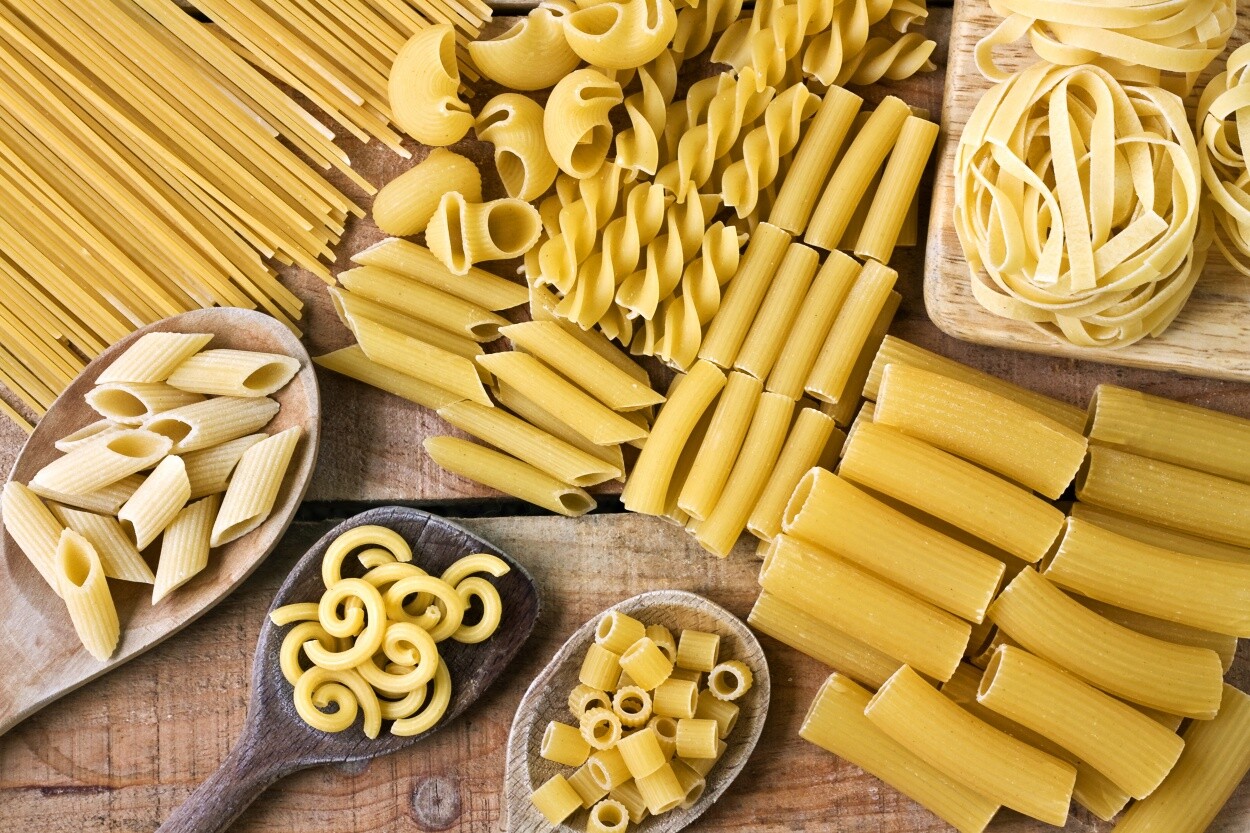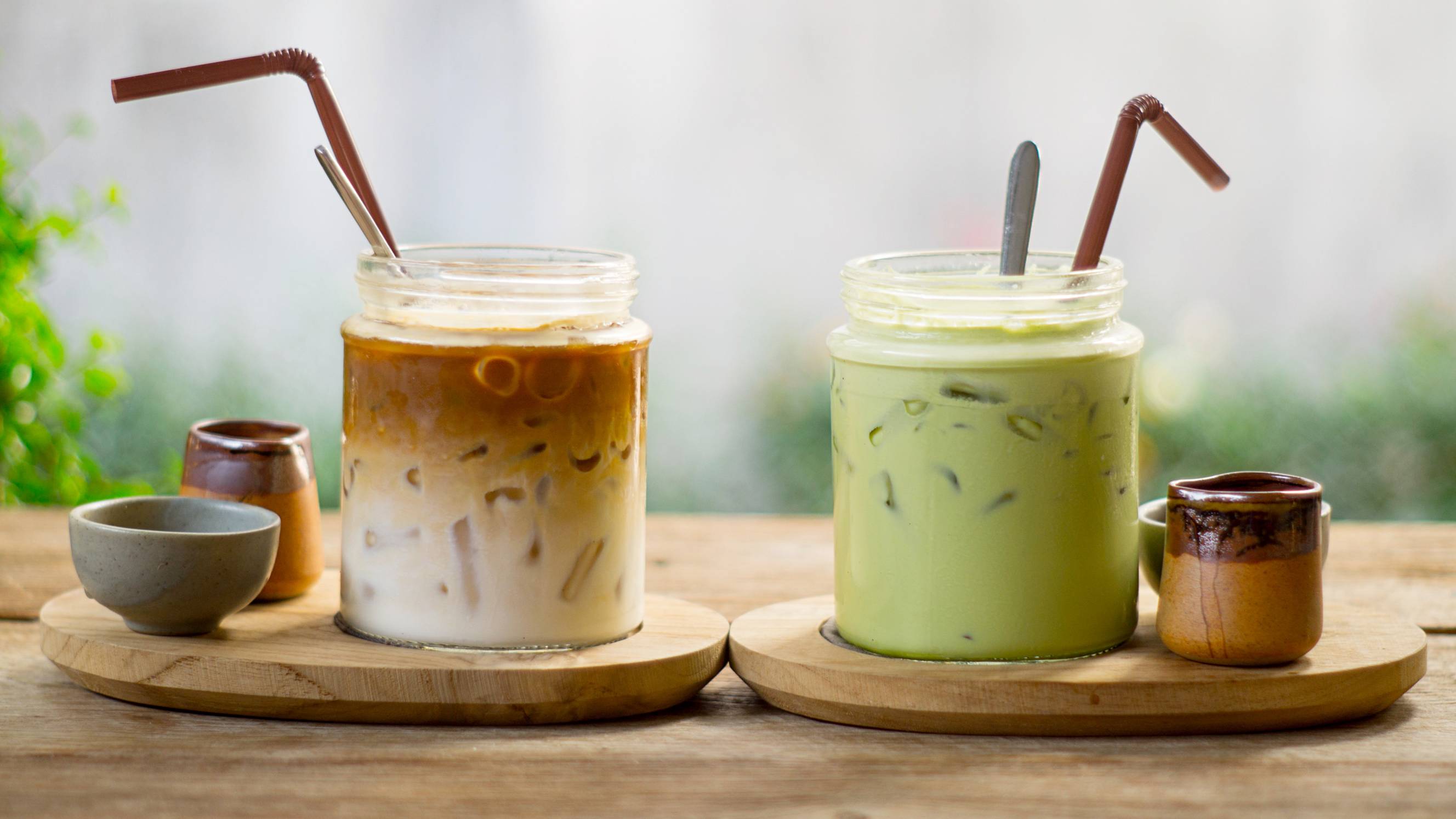
- Home/
- Comparisons/
- Grocery Delivery/
- Ravioli vs Tortellini
Ravioli vs tortellini: What’s the difference between them?
Compare ravioli and tortellini pasta based on their appearance, texture, and more.
Published on

Written by Cielo B.
Staff Writer
Read more about our contributor
Key Facts
Ravioli is an Italian stuffed pasta traditionally made with square egg pasta dough, though it also comes in circular or half-moon shapes like mezzaluna.
Tortellini is an Italian stuffed pasta shaped like a ring or navel, made by folding a square of thin egg pasta dough around the filling and joining the edges to form a ring.
Filled pasta, also known as stuffed pasta, comes in various forms, including ravioli and tortellini. Although they can look similar once covered in sauce, they have unique shapes, textures and traditional fillings.
Whether you’re making a quick weeknight dinner or planning a family meal, knowing the difference between ravioli vs tortellini can help you pick the right pasta for your next Aussie home-cooked feast.
What is ravioli?
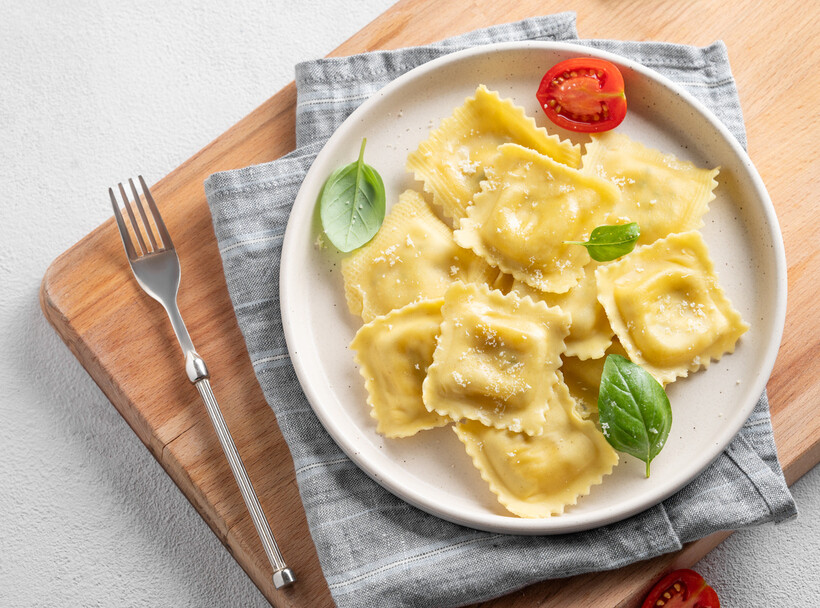 A serving of ravioli pasta topped with cheese and herbs. (Source: iStock)
A serving of ravioli pasta topped with cheese and herbs. (Source: iStock)
Ravioli is an Italian stuffed pasta made with egg pasta dough. The filling is sealed in the dough, which is traditionally square. Nowadays, you can find mezzaluna ravioli in circular or half-moon shapes.
A ravioli-shaped pasta is an old classic stuffed pasta that dates back to the 1300s. It first originated in Liguria, Italy, with the earliest ravioli stuffed pasta recipes featuring a filling of cheese, mixed herbs, and beaten eggs. However, some theories suggest that the Genovesi sailors invented this dish. During long voyages, they often had limited supplies, so their practice was to wrap their leftover portions in dough pockets for a more diverse meal.
Centuries later, different versions of ravioli recipes have been created across Italian regions, each reflecting their unique local culinary traditions. Today, ravioli is readily available in supermarkets worldwide, and many countries can now enjoy it.
What is tortellini?
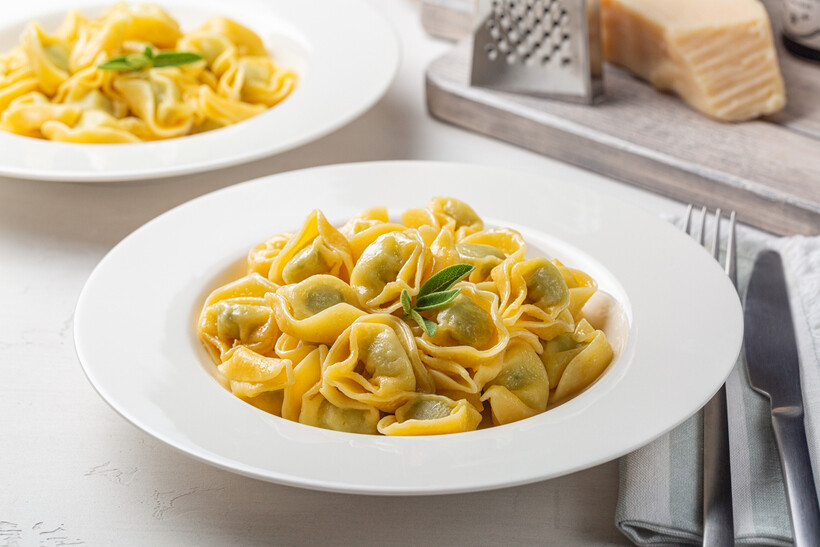 A serving of tortellini pasta garnished with sage leaves. (Source: iStock)
A serving of tortellini pasta garnished with sage leaves. (Source: iStock)
Tortellini is also an Italian stuffed pasta shaped like a ring or navel. It involves folding a square of thin egg pasta dough around the filling and then bringing the edges together to form a ring.
The origins of tortellini pasta can be traced back to northern Italy, particularly the Emilia-Romagna region, where the cities of Bologna, Modena, and Parma reside. However, there have been legends about the origins of Tortellini.
One popular narrative is the Venus’ Navel Legend, in which an innkeeper in an Italian town spied on the Roman goddess of love, Venus, through a keyhole, only seeing her navel. He found her so beautiful that he went to the kitchen in a rush afterwards and made pasta shaped like Venus’ navel, and this is how Tortelli was first created.
Traditionally, many Italians cook Tortellini in chicken broth, which became a staple dish for Christmas and New Year’s Eve. Today, many different kinds of tortellini recipes and fillings have emerged. Some even use sweet fillings like pastry cream, serving it as a dessert.
Tortellini vs ravioli: Which one do you really need?
Both tortellini and ravioli are stuffed pastas rich in flavour, but which of the two is ideal for the recipe you had in mind? Keep reading to find out.
In terms of shape and appearance
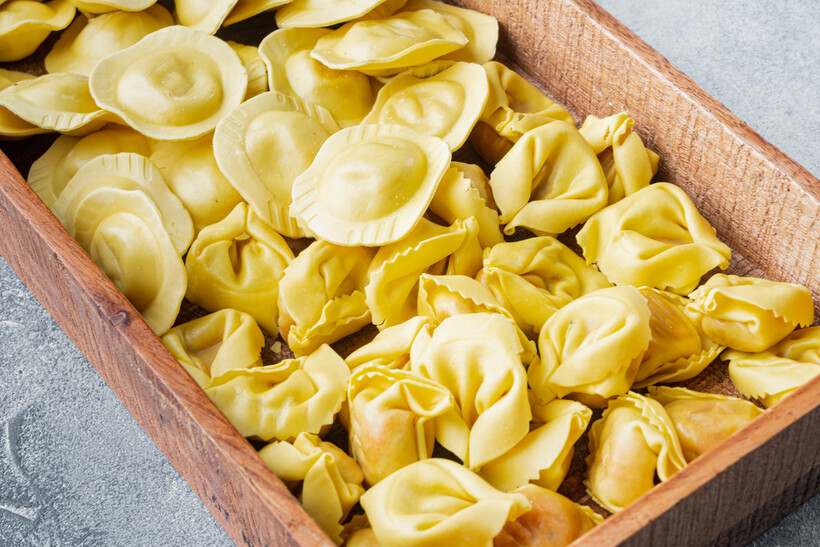 Fresh ravioli and tortellini pasta arranged in a wooden tray. (Source: iStock)
Fresh ravioli and tortellini pasta arranged in a wooden tray. (Source: iStock)
Imagine a small pillow of dough with stuffing – that’s what a ravioli looks like. It has square or circular-shaped pasta pockets with crimped or frilled edges. Moreover, it has a flat bottom and a domed top with the filling seen bulging at the centre.
On the flip side, tortellini looks like a small croissant. It has a distinctive smooth round surface with sealed ends. Unlike ravioli, the filling inside a tortellini isn’t visible because it’s encased within the pasta dough. Also, when you place ravioli and tortellini side-by-side, you’ll notice that the tortellini is smaller and almost bite-sized.
Although these filled pastas have different shapes, they have the same yellowish colour, as both are made from egg pasta. Other variations are made from spinach dough or tomato, so you’ll likely find some with green or red colours.
In terms of taste and texture
The taste of a ravioli can vary widely because it can be made with various fillings. It tastes creamy if stuffed with cheese, hearty with meat, or fresh with vegetables.
Instead of evaluating the taste, look at the texture of the ravioli so you can easily differentiate it from other types of stuffed pastas. Ravioli is thin and tender with a slight al dente if you cook it properly. Also, when you eat ravioli, it feels creamy and chunky with a slight chewiness because of the crimped edges.
Meanwhile, tortellini has a rich and savoury flavour since it’s typically filled with cheese and meat. Its pasta dough is thicker and more elastic, with a chewy texture that gives it a firmer bite. This pasta texture prevents it from getting soggy easily when cooked in broths.
In terms of traditional fillings
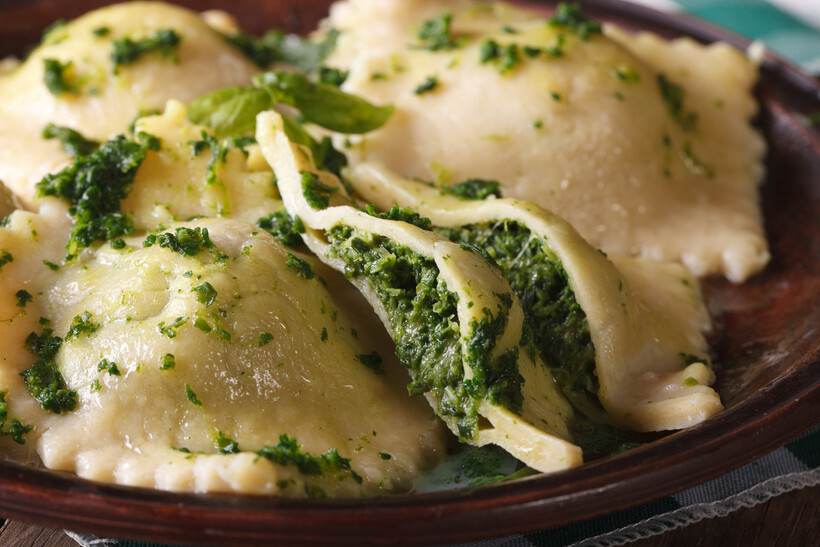 Spinach-stuffed ravioli with a fresh herb sauce. (Source: iStock)
Spinach-stuffed ravioli with a fresh herb sauce. (Source: iStock)
There are three kinds of traditional fillings for tortellini and ravioli: cheese, meat, and vegan-based. For ravioli, a mix of cheeses, including ricotta, mozzarella, and parmesan or Parmigiano Reggiano cheese, is often used to achieve a rich flavour. When it comes to meat fillings, ravioli uses ground beef, pork, or veal with a mix of Italian herbs for added flavour. Some use Italian sausage for a slightly spicy kick.
There are vegan ravioli options, too. For instance, some combine ricotta cheese with spinach, garlic, and nutmeg for a pleasantly earthy taste. Others use butternut squash or pumpkin with nutmeg for a sweet and savoury taste. If you want an earthy, umami taste, sauteed mushrooms and herbs are the best options.
Tortellini uses the same cheese fillings as ravioli, but they differ when it comes to meat fillings. Traditional recipes would use Prosciutto (dry-cured ham) with cheese for a saltier and richer flavour or Mortadella (heat-cured pork Italian sausage) for a mild and slightly sweet flavour.
Unlike ravioli, vegetables are less common in tortellini fillings. Although some recipes use spinach and mushrooms, usually, you can only see tortellini with herbs and spices such as nutmeg, pepper, and salt.
In terms of cooking process
The first step is to boil the pasta on a gas or induction cooktop. Generally, you need 3 to 5 minutes to boil ravioli and tortellini without them getting soggy. If they’re frozen, add 1 to 2 minutes to your boiling time.
Next, drain the pasta and add the sauce after boiling it. Ravioli are commonly served with heavy tomato sauce like marinara or cream-based sauces like Alfredo. You can serve ravioli in broth, but traditionally, many people use tortellini for broth recipes and lighter butter and parmesan cheese sauce. Afterwards, serve the pasta with bread, and use the bread to finish the leftover sauce with the bread after eating the pasta.
Just make sure when cooking filled pasta like tortellini and ravioli, avoid overcooking them to prevent the filling from spilling out. Instead of boiling, you may bake the ravioli and tortellini pasta to keep the filling inside the dough intact.
In terms of dietary restrictions
 Cutting into ravioli served in a butter sauce. (Source: iStock)
Cutting into ravioli served in a butter sauce. (Source: iStock)
Since both ravioli and tortellini have cheese fillings and eggs in their pasta dough, you may have to avoid eating these filled pasta if you’re allergic to dairy. Fortunately, dairy-free options are available for ravioli. However, when it comes to tortellini, dairy-free versions are less common.
Moreover, their dough is commonly made with wheat flour, which contains gluten. So, if you have gluten allergies, look for ravioli and tortellini pasta made from alternative flours like rice, chickpea, or almond flour.
In terms of price
Ravioli is generally more affordable than tortellini because they have a simpler shape and because this type of filled pasta is often mass-produced, meaning it’s readily available in local supermarkets and grocery stores. For reference, ravioli costs as low as $0.56 per 100g in Australia.
On the other hand, tortellini is slightly more expensive because it requires a more intricate preparation and production process. For reference, tortellini costs as low as $0.83 per 100g in Australia.
These cost estimates are based on current supermarket prices and may vary depending on location and brand.
Get ravioli and tortellini delivered straight to you with Airtasker
If you’re busy with work or school and don’t have time to do your weekly shop for ravioli and tortellini, why not have them delivered instead?
With Airtasker, you can easily connect with local grocery delivery service providers who can bring your Italian goods straight to your door. Just post a task to connect with reliable delivery Taskers near you.
Learn more about our contributors

Written by Cielo B.
Staff Writer
Cielo is an experienced content writer who has explored various industries throughout her career. Her expertise, founded on a degree in journalism, includes writing about automotive and home maintenance. Cielo also covers topics like dressmaking, tailoring, and photography since she is a passionate cosplayer who enjoys dressing up as her beloved anime characters.
Ravioli vs Tortellini
Ravioli |
Tortellini |
|
|---|---|---|
Shape and Appearance |
Pillow-like with square or circular pockets; crimped edges; flat bottom, domed top |
Small croissant shape; smooth round surface with sealed ends; filling not visible |
Taste and Texture |
Varies by filling; thin, tender, slightly chewy |
Rich and savoury; thicker, elastic dough; chewy texture, firm bite |
Traditional Fillings |
Cheese (ricotta, mozzarella, parmesan), meat sauce (beef, pork, veal), vegan options (spinach, butternut squash) |
Cheese (similar to ravioli), meat (Prosciutto, Mortadella); less common vegetable fillings |
Cooking Process |
Boil for 3-5 minutes; often served with heavy sauces or in broth |
Boil for 3-5 minutes; best with lighter sauces or in broth |
Dietary Restrictions |
Dairy and gluten are common; dairy-free versions available for ravioli |
Dairy and gluten are common; less availability of dairy-free options |
Price |
More affordable; approx. $0.56 per 100g |
Slightly more expensive; approx. $0.83 per 100g |
FAQs on ravioli and tortellini
There are many types of filled pasta, including the classic ravioli-shaped pasta, ring-shaped tortellini, large tube-like pasta called cannelloni, and rectangular-shaped agnolotti pasta. Each type has a unique filling, which can be meat, vegetables, seafood, or cheese.
They may look alike, but ravioli are square or round and have fillings ranging from cheese to meat or vegetables. Meanwhile, agnolotti are rectangular and have braised meat or vegetable fillings.
Yes, you can substitute ravioli for tortellini, as they can be cooked in broth or with a sauce. However, if you’re going to use ravioli for broth, make sure you add it at the end of the cooking process because, unlike tortellini, the pasta pockets of ravioli can break easily.
Find grocery delivery experts, fast
Post a task
Related articles
